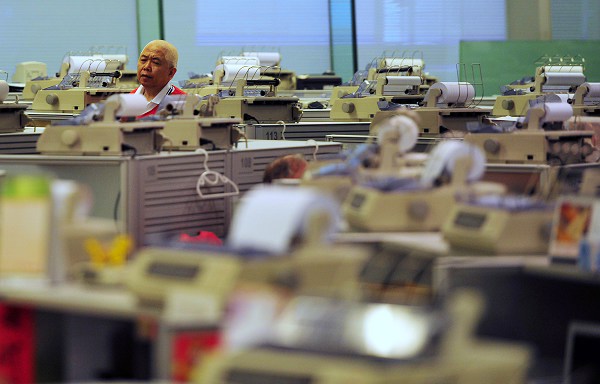Wednesday, 23 September 2015 14:23
 HONG KONG: A plunge in a gauge of Chinese factory activity fuelled fresh fears about the world’s number two economy and the global outlook Wednesday, sending Asian markets tumbling after a heavy sell-off in New York and Europe.
HONG KONG: A plunge in a gauge of Chinese factory activity fuelled fresh fears about the world’s number two economy and the global outlook Wednesday, sending Asian markets tumbling after a heavy sell-off in New York and Europe.
Emerging market currencies — already under pressure from an expected US interest rate rise and weak growth — also took a battering as investors rushed into lower-yielding, or safer, assets such as the yen. Oil prices eased.
The losses extended a downward spiral across the world as dealers fret over the state of the global economy, with a US recovery offset by China’s weakness, while Japan and the eurozone also struggle.
Traders are also watching Chinese President Xi Jinping’s state visit to the United States, where he pledged not to push down the value of the yuan to boost exports.
On Wednesday Hong Kong and Shanghai lost more than two percent after China’s Purchasing Managers’ Index (PMI) of manufacturing activity for September came in at a six-and-a-half-year low and showed the sector contracted further.
The preliminary reading released by financial publisher Caixin came in at 47.0, down from August and missing expectations of 47.5. A result below 50 indicates shrinkage and anything above points to growth.
“The decline indicates the nation’s manufacturing industry has reached a crucial stage in the structural transformation process,” He Fan, chief economist at Caixin Insight Group, said in a statement.
He blamed the weakness mainly on sluggish external demand and lower export prices.
The figures come a day after the Asian Development Bank lowered its growth expectations for the region because of the troubles in China, a key driver of global trade.
“It’s a confirmation of fears that were existing in the market already that China is in fact doing worse than we had been led to believe and there’s a lot of uncertainty about where that economy really is,” Emma Lawson, senior currency strategist at National Australia Bank in Sydney, told Bloomberg News.
Shanghai stocks closed 2.19 percent lower and Hong Kong plunged 2.26 percent. Sydney — where a number of firms with strong China links are listed — ended down 2.07 percent.
Seoul lost 1.89 percent and Taipei closed more than two percent down.
– Flight to safety –
====================
The safe-haven yen advanced. The dollar bought 120.10 yen compared with 120.14 yen in New York Tuesday, while the euro was at 133.61 yen against 133.74 yen.
World bourses have largely been on a slide since mid-August when China announced a shock devaluation of its yuan currency, feeding fears it is in more trouble than first thought and raising questions about its leaders’ ability to deal with the crisis.
The country has suffered a series of weak data, from trade and investment to consumer spending and inflation, despite five cuts in interest rates since November.
On Tuesday Xi, on his first day in the United States, told businessmen and state officials Beijing would stick to its plan to let the yuan adjust by market forces.
“Given the economic and financial situation at home and abroad, there is no basis for continuous depreciation,” he said. “We are against competitive depreciation or currency war.”
The Australian dollar, which is heavily reliant on resources exports to China, tumbled 0.66 percent Wednesday, while other emerging units also suffered in a flight to safety.
South Korea’s won lost one percent, while the Indonesia’s rupiah fell 0.64 percent to a 17-year low. The Malaysian ringgit was 0.95 percent lower, while the Thai baht and Singapore dollar were also down.
Adding to selling pressure in weaker currencies are expectations of a US rate rise after three Federal Reserve presidents said they expect to see one by year-end.
The Fed held off a rise last week, citing China’s slowdown and turmoil in global markets, which in turn fuelled worries about the health of the United States.
On Tuesday US stocks and European bourses tanked on world growth concerns as well as the wider impact of the Volkswagen emissions scandal on the auto sector.
The Dow, S&P 500 and Nasdaq all lost more than one percent. Paris shed 3.42 percent and London fell 2.83 percent, while Frankfurt dumped 3.80 percent with VW shares losing 35 percent over two days.
Oil prices dropped after the data from China, the world’s biggest energy user. US benchmark West Texas Intermediate was 0.10 percent lower and Brent crude retreated 0.14 percent.




























